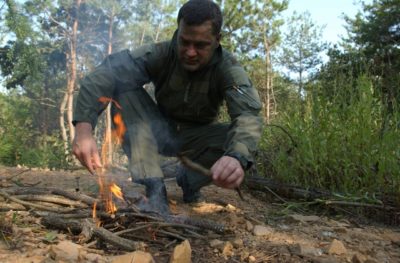 In any survival situation, the ability to make fire is one of the most crucial elements. Most survivalists will compile a list of the bare essentials to being prepared: having a good supply and/or source of food and water, having good security to protect yourself and your family, a backpack of survival items, and perhaps even a bug-out location.
In any survival situation, the ability to make fire is one of the most crucial elements. Most survivalists will compile a list of the bare essentials to being prepared: having a good supply and/or source of food and water, having good security to protect yourself and your family, a backpack of survival items, and perhaps even a bug-out location.
But nothing will provide you with as much heat, light and the ability to cook on your own as a simple fire. Every real survival pack should contain a bare minimum of at least two or three different ways to make fire. The most popular ways of doing so includes matches, a magnesium flint striker, and a lighter (with the fuel required to light it, of course). In addition, every survivalist and prepper should practice using each of these fire-making methods extensively.
While it’s absolutely a good thing to have all of these fire-starting materials and to always keep your skills sharp with them, there may arise a situation where you need a fire but don’t have these traditional materials. Maybe you’ve used up all your fuel or all your matches, maybe you’ve lost or misplaced them, or perhaps you were away from your survival kit when something happened. In this scenario, you may find yourself out of luck … unless you know how to build a fire without matches, a flint striker, a lighter, or another type of fire-starting material. It’s imperative that you know at least a couple of ways to properly start a fire without any of these methods. This article will discuss just a few of the many different methods for making a fire without fire-starting materials.
It Is Safe, Will Burn On Snow, In Rain & In 30 MPH Winds, All Natural Fuel…
Of course, before you begin making any fire, you should always know why you are making the fire in the first place, and to make sure that you are in a suitable location. Are you making a fire to cook food? To get warm? To have light in the middle of the night? And are you in a location where the wind will affect the fire? Do you have enough wood in your location to fuel the fire? All of these questions must be taken into consideration before building your fire.
1. Fire bow. One of the most common and effective ways of starting a fire is to use the fire bow method. For this, you should have some tinder on standby, a spindle, a stick with a bend to it, a cord tied to both ends of the wood, and a baseboard. Cut an indention into the baseboard with your knife, and then place the end of your spindle into this indention. Loop the cord of your bent stick around the spindle. Proceed to use the bent stick (or bow) to spin the spindle into the indention rapidly. This process will require a great deal of time and effort, but if successful, you should eventually start to see some smoke, after which you can blow the smoke into your tinder pile to create a spark. You should always practice using the fire bow method at your home or out in the woods, so that you know you’ll be able to do it once the need arises. The fire bow method is the most common method for starting a fire if you have absolutely no traditional fire-starting materials that you can buy from a store or online.
2. Steel wool and flashlight. Another proven method is to use steel wool and a flashlight; you simply break the light and separate the two electrodes so that they both touch the steel wool, and then turn on your flashlight. Keep it on until the steel wool turns red. Then take your tinder and place it next to the wool. If you blow on the smoke, a fire should ensue. Of course, this method only works assuming you have a flashlight and some form of steel wool with you.
Story continues below video
3. Glass. Use the sun and a piece of glass. Prepare some tinder on a hot, sunny day, and then hold the glass in between the sun and the tinder. If positioned right, the rays of the sun should travel through the glass and eventually cause some smoke to result on the tinder. Calmly blow into the smoke to catch a spark.
These are just a sample of the many different, creative methods you can use to start a fire without the use of fire starters. They may require a great deal of patience and energy, but if you practice doing them when you get the chance, they will serve as a viable backup option to a fire starter. The ability to make fire is absolutely essential to survival in almost every situation, and having the skill to make it without the use of fire starting tools will make you much less reliant.
What survival methods of starting a fire do you use? Tell us in the comments section below.
Sign up for Off The Grid News’ weekly email and stay informed about the issues important to you
 Off The Grid News Better Ideas For Off The Grid Living
Off The Grid News Better Ideas For Off The Grid Living




